The Best Dark Chocolate Bars of 2024, According to Our Taste Tests
Dotdash Meredith and Yahoo Inc. may earn commission or revenue on some items through the links below.
Discover the best dark chocolates from around the world
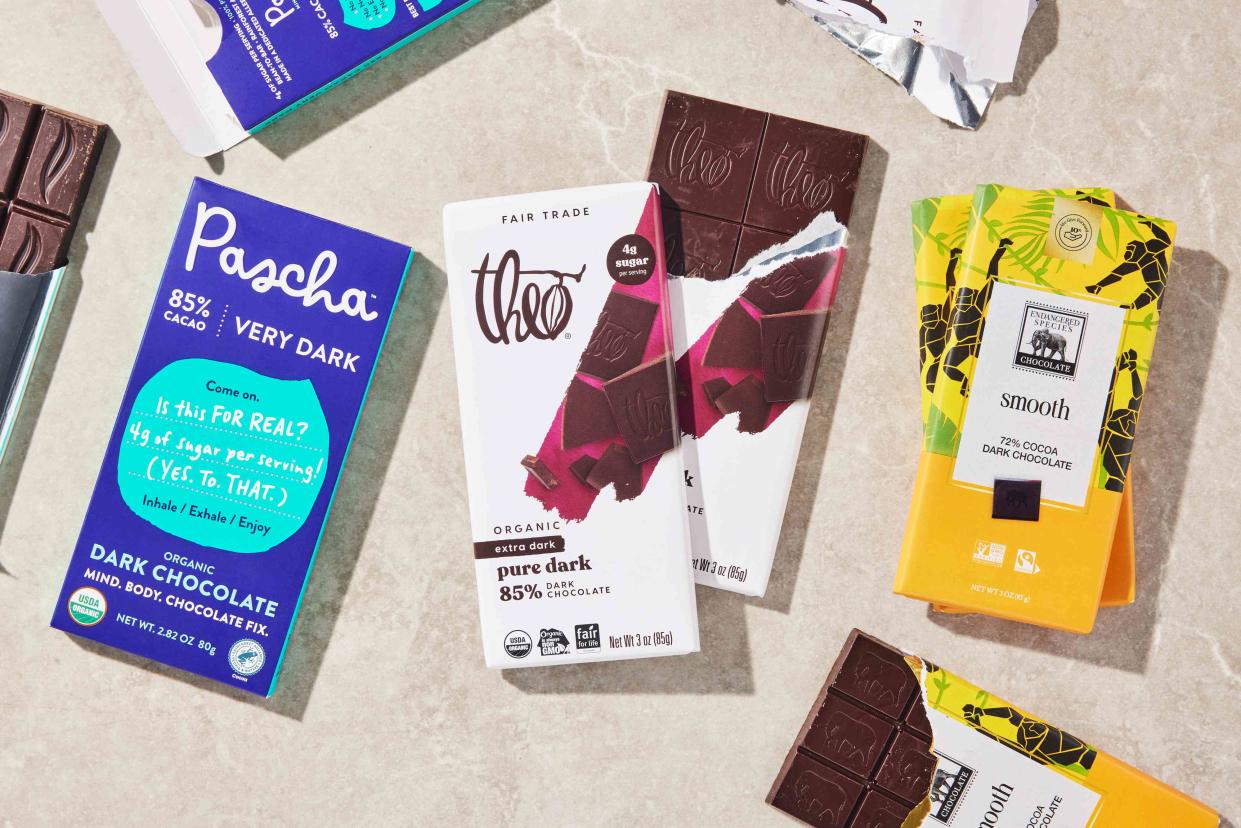
EatingWell / Russell Kilgore
Reviewed by Dietitian Brierley Horton, M.S., RD
Who doesn't crave a piece of chocolate from time to time? There’s nothing quite like reaching for a square or two of chocolate for a mid-afternoon pick-me-up or as a sweet treat after a meal. There are a variety of chocolate profiles, from white to light to dark, that are there for the tasting—but one of them is the healthiest.
Dark chocolate has been shown to have numerous health benefits: It’s chock full of antioxidants (compounds that scavenge for and mop of harmful free radicals in our bodies), eating it regularly may help lower blood pressure and potentially improve heart health. But not all dark chocolates are made equally, and with so many options on the market, choosing a good bar can feel overwhelming—especially when it comes to the finer stuff, like craft chocolate.
We set out to find the best dark chocolate bars that are created with natural ingredients and ethical sourcing standards—two factors that signal a high-quality craft bar, according to the chocolate experts we interviewed. Thanks to our eager tasting panel (it’s sweet work, but someone has to do it), we’ve snapped, nibbled and savored 12 different dark chocolate bars and assessed them on multiple qualities, from texture to aroma to origin to cacao content. If you live by the motto “the darker the chocolate, the better,” we have you covered with our top picks.
Our Dark Chocolate Recommendations
Best Overall: TCHO Dark Duo, 75%
Best Value: Equal Exchange Organic Very Dark Chocolate (71% Cacao)
Best Splurge: Amano Artisan Chocolate Dos Rios Dark Chocolate Bar 70%
Best Allergen-Free: Pascha 85% Cacao Organic Vegan Dark Chocolate Bar
Best Overall: TCHO Dark Duo, 75%
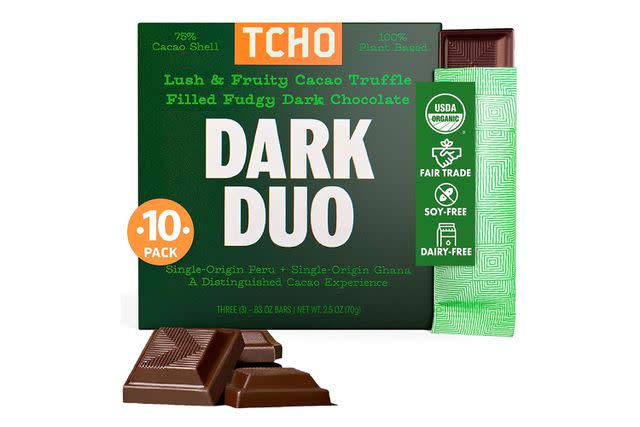
Amazon
What we like: With transparency and research at its core, TCHO works to ethically source cacao around the globe.
What to know: Since the bars come individually wrapped, we think the packaging is a little excessive and less environmentally friendly.
Berkeley, California-based chocolatier TCHO (pronounced “cho”) has been sourcing and crafting fine chocolates for nearly 15 years and cleverly coins its chocolate bar-making process as “pod to palate.” Research is fundamental to the company, which makes sense as TCHO was founded by Timothy Childs of NASA alongside chocolate veteran Karl Bittong. And they take their “craft” seriously, setting up partnerships worldwide with tasting labs and scientific research centers. TCHO also partners closely with cacao farmers to ensure sourcing is fair and the product exemplary. Bars are certified organic by CCOF and fairly-traded, and TCHO loves welcoming visitors and chocolate-lovers into the Bay Area lab for facility tours.
The dark chocolate bar that stole our hearts is the Dark Duo, which is both soy- and dairy-free, non-GMO and certified kosher. This bar features 75% dark chocolate from Ghana with a fudgy dark chocolate cacao filling from Peru—both of which are single-origin. When we tasted this bar, we loved its flawlessly glossy and silky appearance, as well as its rich hickory hue with hints of auburn undertones. The bar snapped easily with a clean break and very few crumbs, revealing an almost fudge-like center.
In terms of aroma, we observed forward notes of aromatic fruit and mocha with hints of nuttiness. The texture of the Dark Duo is smooth, rich and buttery, with a melt-in-your mouth feel like a ganache or chocolate mousse. Tasting notes revealed jammy flavors and dark-roasted coffee tones that intensified bite after bite with a long lingering finish. We loved the richness and nuanced flavors of the bar, which include fruits, such as raisin and red currant with a touch of anise, a bit of nuttiness, and a gorgeously silky mouthfeel.
Weight: 2.5 oz | Origin: Ghana, Africa and Peru, South American | Cacao Percentage: 75% | Vegan? Yes
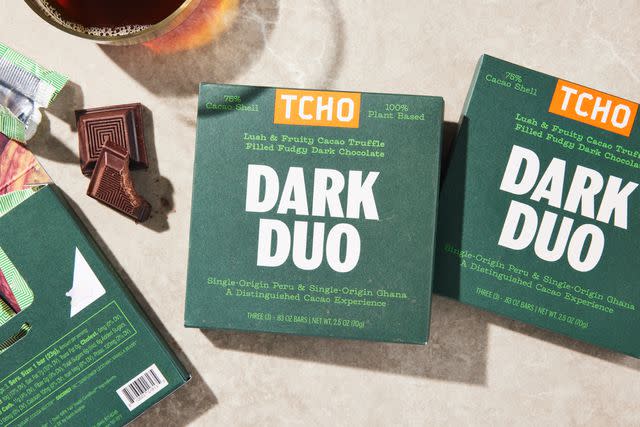
EatingWell / Russell Kilgore
Best Value: Equal Exchange Organic Very Dark Chocolate (71% Cacao)
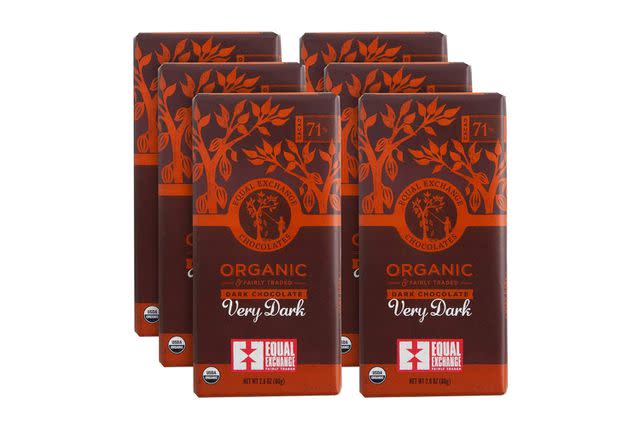
Amazon
What we like: Organic ingredient sourcing in tandem with small co-op farmers.
What to know: We found this bar a bit more bitter than others.
Since 1986, Equal Exchange has been on a mission to ensure fair-traded channels with small co-op farmers in Latin America. Originally focused specifically on sourcing coffee beans, Equal Exchange’s mission has grown to include chocolate, tea and other dry goods while ensuring ethical trade measures and fair wages to over 40 farms globally.
Equal Exchange chocolates are made with beans grown by small cacao co-op farms. The Organic Very Dark Chocolate, which we tested in our Lab, is made of 71% cacao derived from the Dominican Republic and Peru. Additional ingredients, such as the organic sugar, comes from Costa Rica and Paraguay, and the organic vanilla hails from Madagascar. This dark chocolate bar is vegan, certified kosher, free of soy and gluten and certified organic by Oregon Tilth.
When we tried this chocolate, we noticed the overall appearance of the bar was more matte than glossy, with some slight bloom and chalkiness and a hickory-brown hue. The chocolate bar easily snapped into a clean break, and the aromatic notes included light toffee, plum and raisins. We noted more tannin-forward tasting notes alongside hints of mocha, marshmallow, raisins and burnt caramel with a slow melting point in the mouth and a sharper bitter finish.
Weight: 2.8 ounce | Origin: Dominican Republic, North America and Peru, South American | Cacao Percentage: 71% | Vegan? Yes
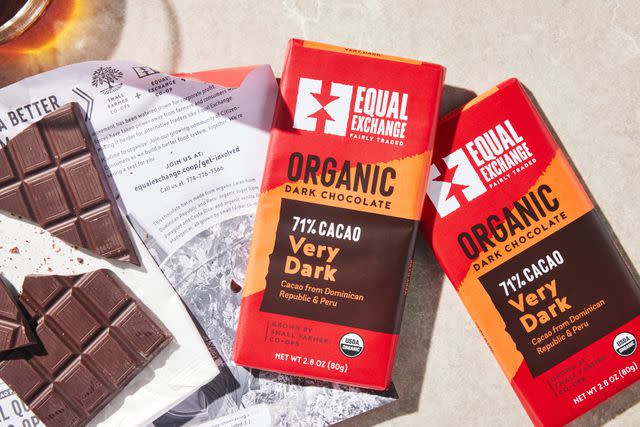
EatingWell / Russell Kilgore
Best Splurge: Amano Artisan Chocolate Dos Rios Dark Chocolate Bar 70%
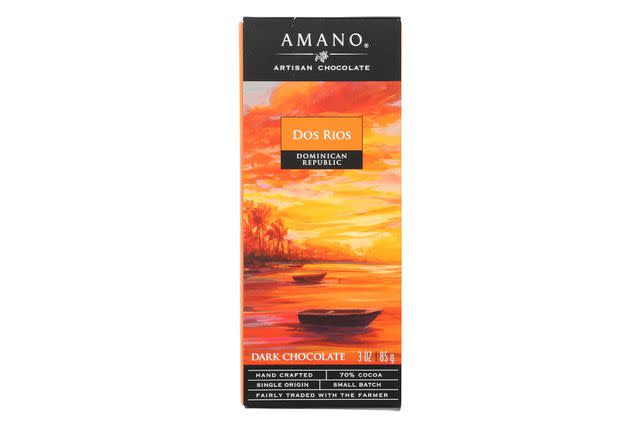
Amazon
What we like: Amano thoughtfully sources rare and precious cocoa beans from small-batch farmers.
What to know: Chocolate bar prices tend to be on the high end.
This small batch chocolate bar is a decadent treat—so much so that the Amano chocolatier refers to it as “magic” for its nuanced natural flavors. A family-run business that follows traditional chocolate making practices, Amano is based in the Utah mountains and was named after the Italian words of “they love” and “by hand.”
The company carefully sources special craft beans from around the globe, and this particular Dos Rios Dark Chocolate Bar features cocoa beans from the Dominican Republic. Each three-ounce bar arrives individually wrapped and is vegan, gluten-free and non-GMO.
When we unwrapped our Dos Rios bar, we noticed a smooth and slightly glossy texture with very little visual imperfections. While it required a bit of force to snap this bar in two, we achieved a clean break with very little crumbling. The aroma gave us fruit-forward notes of raisins and prunes, along with a slight sourness, and tasting notes included raspberry, bitter orange, salted caramel and licorice.
As the chocolate melted in our mouths, the bar maintained a full-bodied mouth feel and the flavors stayed consistent. On the back end, the flavors were punctuated by notes of coffee and orange pith and peel.
Weight: 3 ounces | Origin: Dos Rios,Dominican Republic | Cacao Percentage: 70% | Vegan? Yes
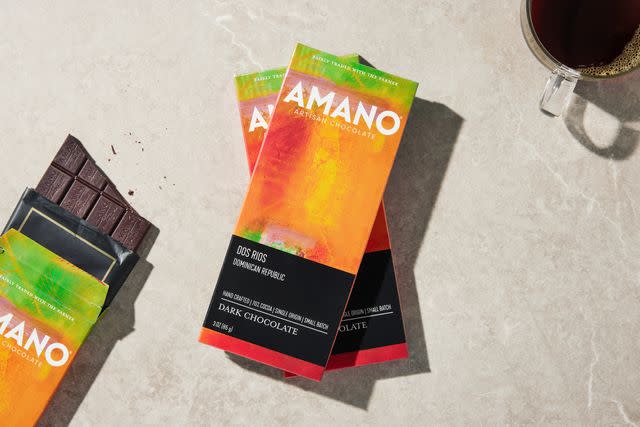
EatingWell / Russell Kilgore
Best Allergen-Free: Pascha 85% Cacao Organic Vegan Dark Chocolate Bar
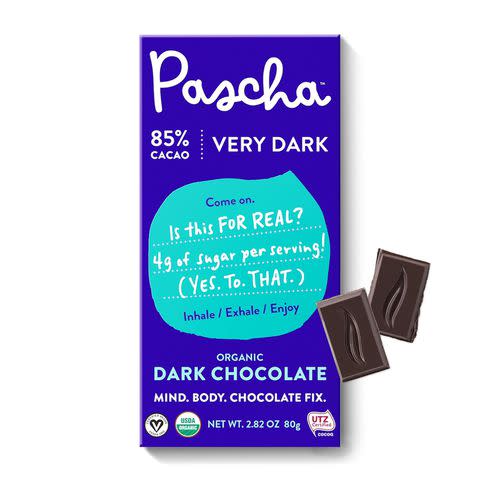
Amazon
What we like: Chocolate is made in adedicated allergen-free facility with high ethical standards.
What to know: Pascha’s chocolate bars are not readily available in grocery stores internationally.
Pascha Chocolate focuses on creating craft chocolate without additives, fillers, or major allergens. With just 4 grams of sugar and no added soy lecithin, Pascha uses cocoa butter for the ultimate creamy texture. The company sources its beans from the Peruvian Andes mountains to the Amazon rainforest, where fresh cocoa beans are collected and brought to a nearby dedicated chocolate factory that is free from the major eight allergens.
Pascha’s bars are organic, plant-based, keto-friendly, non-GMO, kosher and gluten-free. Pascha is also Rainforest Alliance-certified, meaning there are high ethical and sustainable practices and no forced child labor.
At first glance, the 85% Cacao Organic Vegan Dark Chocolate Bar showed no blooming and a relatively silky appearance with darker reddish-rust and a hickory hue. The aroma included hints of moss, oat, toffee with slightly acidic undertones, and the bar gave off a loud, clean and crisp snap when broken. When we tasted the Pascha chocolate bar, it had a very smooth mouthfeel with notes of peanut butter, coconut and burnt caramel. As the chocolate melted on the tongue, there was a very faint bitterness and flavors of cinnamon, earthiness and a sweet raspberry finish.
Weight: 2.8 ounces | Origin: Peru | Cacao Percentage: 85% | Vegan? Yes
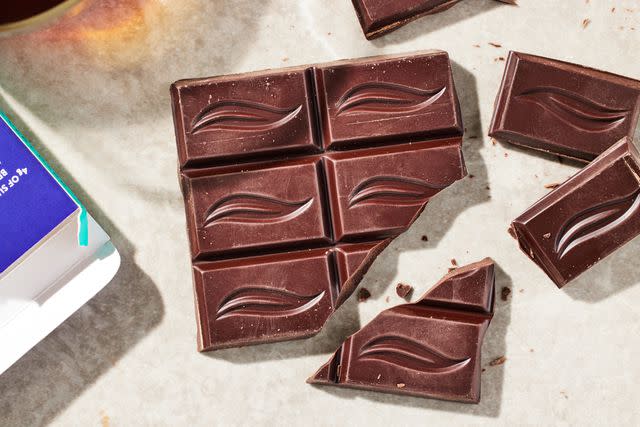
EatingWell / Russell Kilgore
The Bottom Line: The Best Dark Chocolate Bars
When it comes to craft dark chocolate bars, the TCHO Dark Duo (view at Amazon) is our favorite. We love the smooth texture, long finish and fruit and coffee notes of this bar, and its applaudable company mission and dedicated research labs were the icing on the cake. If you’re looking for a splurge, the Amano Artisan Dos Rios bar (view at Amazon) is an excellent treat.
Choosing a Dark Chocolate Bar
Ingredients
When choosing a high-quality dark chocolate bar, it’s important to take a close look at ingredients. Cacao can often be a bit bitter, so many conventional chocolate manufacturers add extra sugar as well as emulsifiers and additives like soy lecithin to add texture and depth. Ingredients such as cocoa butter, however, can be a more natural way to achieve the desired texture and integrity of a chocolate bar.
When choosing a gourmet bar, chocolate expert Kathy D’Agostino of Chocolatá suggests giving the ingredient list a thorough read and trying to avoid fillers and unnecessary flavorings. “The fewer the ingredients, the better,” says D’Agostino. “Some people put wax or paraffin in [the chocolate] to replace the cacao butter. You want cacao, cacao butter and sugar.”
Finally, if you suffer from a particular allergy or follow a vegan diet, taking a close look at a chocolate bar’s ingredient list can help you decipher if a dark chocolate bar is vegan or dairy-free, and if any factories call out allergen-friendly manufacturing practices.
Sourcing and Transparency
Historically, the chocolate industry has been known to have some unethical practices, such as child labor, unfair farmer wages and even deforestation. However, thanks to third-party certifications, it’s a bit easier to understand which chocolate makers are compliant with safe, ethical, and transparent sourcing. Looking for labels such as USDA-organic, Fairtrade, and Rainforest-Alliance can be helpful when choosing an ethically produced chocolate bar.
Percentage of Cacao or Cocoa
When it comes to chocolate, you’ll want to look at the cacao and cocoa percentages—the darker the chocolate, the higher the percentage. Since the cacao and cocoa beans boast many health benefits, chocolate bars with higher cacao or cocoa percentages will most likely have more health benefits than those with lower percentages. Choosing bars with at least 70% cacao or cocoa is a good starting place.
Our Dark Chocolate Tests
To find the best dark chocolate out there, we enlisted a team of tasters to sample over a dozen high-end craft dark chocolate bars. For each bar, we observed the appearance, including the glossiness, color and hue, and looked for any signs of blooming or bubbling. We broke each chocolate bar in half to observe how “snappy” it was—an indication of the quality of production. (Did it give us a clean break? Did it crumble into pieces afterward?) If it doesn't snap well and crumbles then it suggests the chocolate wasn't tempered properly. After cleansing our palates with water and saltines, we placed a piece of chocolate on our tongues to observe the texture (i.e. gritty or smooth) and the taste, mouthfeel and any lingering flavors. We also researched the sourcing and manufacturing practices of each chocolate producer. Other factors we considered were the origin of the chocolate, the cacao percentage (at least 70%), the ingredients and dietary considerations (like vegan or allergy-free), and the value and overall quality of each chocolate bar.
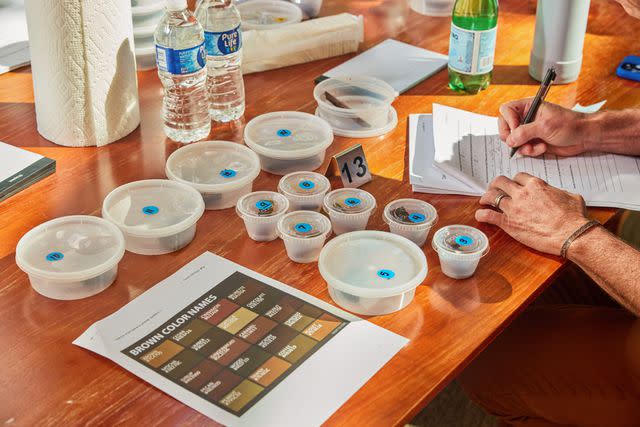
EatingWell / Russell Kilgore
We Also Considered
K+M Chocolate 85% Hacienda Victoria Ecuador (3-pack for $30 at Amazon):
This was a wonderful option and a close runner-up to the ones on our list—a luxurious, glossy chocolate with distinct notes of earthiness and a viscous, velvety finish. Ultimately, though, we thought this bar was a tad too expensive.
Endangered Species Dark Chocolate—Bold + Silky, 72%(AKA "Smooth")(12-pack for $39 at Amazon): We were not overwhelmed by the quality of this bar, but did enjoy the lingering flavors of earthy smoke, tobacco and coffee notes.
K'UL Chocolate Bar—Pure Dark Chocolate, 80% (12-pack for $51 at Amazon): We enjoyed the lovely notes of licorice, fruit and tea, and we appreciated the long-lasting flavors and growing aftertaste of orange pith and tannins. With that said, we did not find this bar exceptional or very unique.
Beyond Good Organic 70% Madagascar Dark Chocolate Bar ($9 per bar at Amazon): When we tasted this bar, we observed notes of umami soy flavors, herbs and black tea, but the taste ends with a short, unremarkable finish.
Raaka Philippines 71% Classic Dark($8 per bar at Raaka): We appreciated the aromatic cacao aromas, but found the bar was chalky and rather mild in flavor.
Taza Chocolate Bars—Deliciously Dark, 70% (10-pack for $45 at Amazon): The texture of these bars was very rough and gritty due to the unrefined, stone-ground chocolate. While we appreciate the manufacturing process, we found the texture distracting.
Theo 85% Dark Chocolate Bar(6-pack for $26 at Amazon): This bar coats the mouth well and has pleasant notes of almond, peanut butter and toasted sesame, with the gentle presence of tannins throughout. However, there was a distinct bitterness on the back end that we didn’t love.
Common Questions
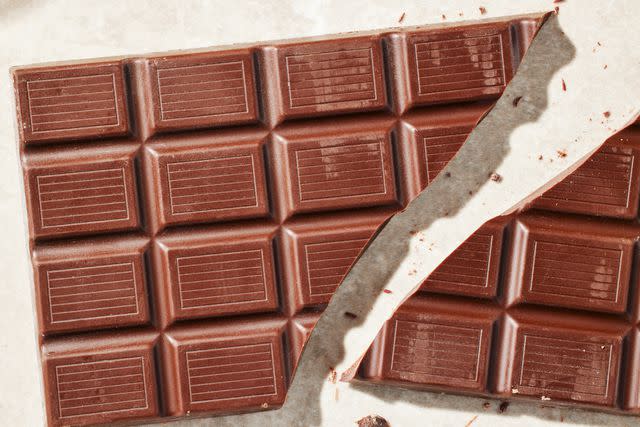
EatingWell / Russell Kilgore
What are the health benefits of dark chocolate?
Dark chocolate boasts several health benefits: It may improve heart health, help lower diabetes risk and can even help reduce depression. Dark chocolate tends to pack a healthy boost of fiber, too. But not all chocolate bars are created equally, and some chocolates contain ingredients that are not so healthy. To reap the benefits of dark chocolate, look at the cacao percentage (higher usually equals better for you) and be mindful of added ingredients, including excess added sugar, which is used to mitigate the “bitter” taste in dark chocolate bars.
Is dark chocolate vegan?
Fortunately for vegans, many dark chocolate bars are vegan. Certain chocolatiers place great care into selecting and using natural and very specific ingredients when crafting dark chocolate bars—whereas some larger chocolate mass-producers may use fillers, such as dairy, to change the structure and texture of bars. When searching for vegan chocolate, take a close look at the list of ingredients and the fine print to make sure the manufacturer does not use dairy or animal products in its bars.
Does dark chocolate have heavy metals in it?
Consumer Reports recently led a study that found increased levels of heavy metals, such as cadmium and lead, in over one-third of dark chocolate tested. High levels of metals can harm your immune system, raise your blood pressure, and cause other negative health effects. In young children and pregnant women, the effects can be worse. Dark chocolate may be more susceptible to heavy metals because cacao beans contain more cocoa solids, and metals can accumulate in those solids. Experts recommend limiting your consumption of dark chocolate, especially for children, and enjoying it in moderation.
What’s the difference between craft chocolate and conventional chocolate?
Sophia Rea, steward of chocolate, owner of Projet Chocolat and Atlas Obscura chocolate course teacher, explains that large chocolate producers often use cheaper and lower-quality cacao than craft chocolate makers. “Industrial chocolate is mass-produced and is uniform in taste, while craft chocolate is more nuanced" Rea says. "This is because craft chocolate makers work with the intention of focusing on the flavor of the beans they are working with, using transparency with cacao bean sourcing and making chocolate in smaller batches.”
To distinguish between conventional and craft chocolate, D’Agostino recommends looking to see if the chocolate maker lists the region the cacao was sourced from. “If the region is listed, then you know the company is paying close attention to sourcing, and that’s a sign of higher quality chocolate.” Price can also be an indicator; D’Agostino says it “costs a lot more to make fine chocolate, as cacao butter is really expensive.”
Lastly, D’Agostino suggests checking to see if the bar was tempered properly. Tempering refers to the process of heating and cooling chocolate, and when done correctly, it makes the chocolate “glossy, shiny, and snappable.” A chocolate bar should snap cleanly and easily; if it crumbles, then the chocolate bar may have not been tempered properly.
Our Trusted Expertise
Marisa Olsen has more than 10 years of experience writing and reporting on food, lifestyle and product reviews, and she has written for multiple publications including Chowhound, Southern Living, The Spruce Eats, Food & Wine, Byrdie and Liquor.com. Marisa has been a dark chocolate lover since a young child, thanks to her father's passion for high-cacao-content chocolate bars, and she ends her evenings with a piece (or two) of dark chocolate every night.
For this article, we also consulted chocolate experts Kathy D’Agostino of Chocolatá and Sophia Rea of Projet Chocolat for insights on how to identify the highest-quality dark chocolates and what distinguishes craft chocolate from conventionally made chocolate.
This article was edited by Kayleigh Drake, a former full-time baker and current EatingWell commerce editor and contributor to publications such as Food & Wine, The Spruce Eats and Simply Recipes. It was reviewed by Brierley Horton, M.S., RD, Senior Commerce Editor (pictured below), who has 15 years of experience reporting, writing, and editing nutrition and health content—and participated in the dark chocolate taste test.
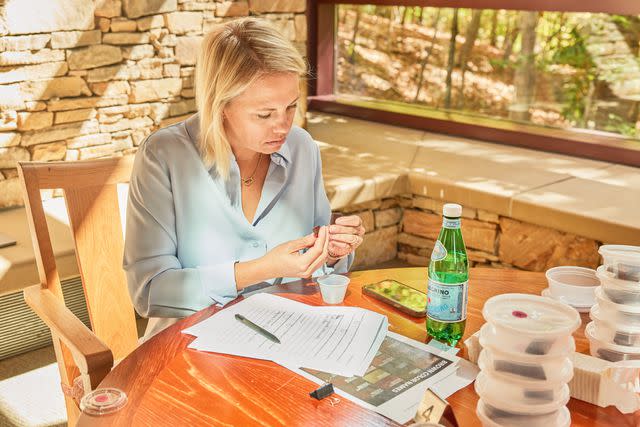
EatingWell / Russell Kilgore
Read the original article on Eating Well.






